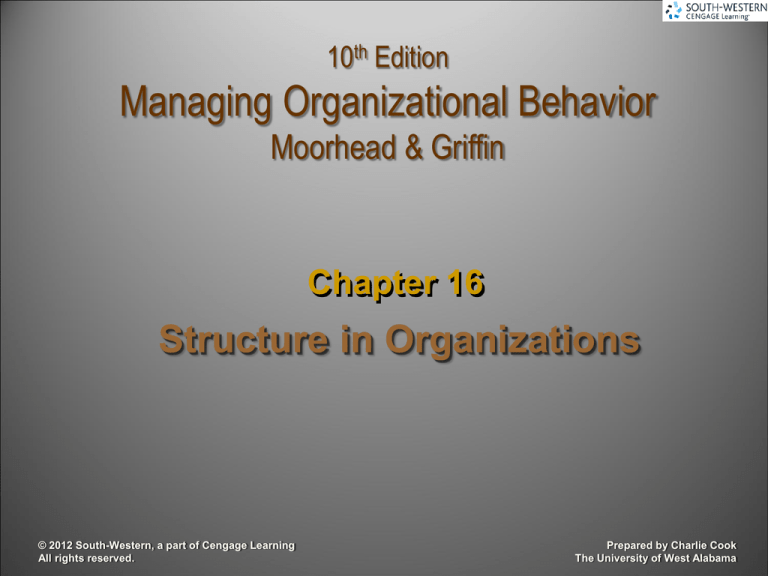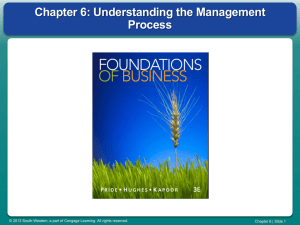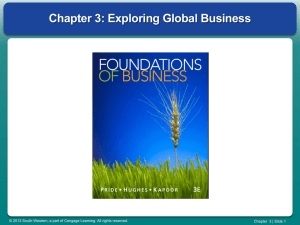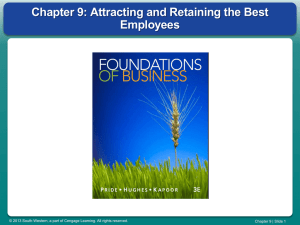
10th Edition
Managing Organizational Behavior
Moorhead & Griffin
Chapter 16
Structure in Organizations
© 2012 South-Western, a part of Cengage Learning
All rights reserved.
Prepared by Charlie Cook
The University of West Alabama
Chapter Learning Objectives
After studying this chapter you should be able to:
• Define organization structure and discuss its purpose.
• Describe the classic views of organization structure.
• Describe structural configuration and summarize its
four basic dimensions.
• Discuss two structural policies that affect operations.
• Explain the dual concepts of authority and
responsibility.
© 2012 South-Western, a part of Cengage Learning
16–2
The Nature of Organization Structure
• Organization
–A goal-directed social entity with deliberate processes
and systems
• Organizational Goals
–Objectives that management seeks to achieve in
pursuing the firm’s purpose
• Strategies
–Specific action plans that enable the organization to
achieve its goals and thus its purpose
© 2012 South-Western, a part of Cengage Learning
16–3
The Nature of Organization Structure
(cont’d)
• Organization Structure
–The system of task, reporting, and authority
relationships within which an organization does its work
–Purpose of structure is to order and coordinate the
actions of employees to achieve organizational goals
–“Structure follows strategy”
© 2012 South-Western, a part of Cengage Learning
16–4
The Nature of Organization Structure
(cont’d)
• Organized Effort Premise
–People can accomplish more by working together than
they can separately
–Proper coordination is needed to realize the potential
gains from collective efforts
• Analysis of Organizational Structures
–Configuration (organization chart)
–Operational characteristics
–Responsibility and authority
© 2012 South-Western, a part of Cengage Learning
16–5
Structural Configuration
• Organization Chart
–Describes the structure of an organization
• Shows all people, positions, reporting relationships, and lines
of formal communication
• Depicts reporting relationships and work group memberships
• Shows how positions and small work groups are combined
into departments which make up the shape (configuration) of
the organization
• Basic Requirements of Structure
–Division of labor
–Coordination of divided tasks
© 2012 South-Western, a part of Cengage Learning
16–6
16.1
Examples of
Organization
Charts
© 2012 South-Western, a part of Cengage Learning
16–7
Structural Configuration (cont’d)
• Division of Labor (Specialization)
–The way the organization’s work is divided into
different jobs to be done by different people
–Organizations, in order to be successful, must have
highly trained specialists who know their specific jobs
very well
• Coordinating the Divided Tasks
–Mechanisms to help coordinate the divided tasks
• Departmentalization
• Span of control
• Administrative hierarchy
© 2012 South-Western, a part of Cengage Learning
16–8
Structural Configuration (cont’d)
• Departmentalization
–The manner in which divided tasks are combined
and allocated to work groups
–A consequence of the division of labor
–Ways to departmentalize tasks:
• Business function
• Process
• Product or service
• Customer
• Geography
© 2012 South-Western, a part of Cengage Learning
16–9
16.1
Advantages and Disadvantages of Division of Labor
Advantages
Disadvantages
Efficient use of labor
Routine, repetitive jobs
Reduced training costs
Reduced job satisfaction
Increased standardization
and uniformity of output
Decreased worker involvement
and commitment
Increased expertise from
repetition of tasks
Increased worker alienation
© 2012 South-Western, a part of Cengage Learning
Possible incompatibility with
computerized manufacturing
technologies
16–10
Structural Configuration (cont’d)
• Departmentalization (cont’d)
–Span of control (also span of management)
• The number of people who report to a manager
• The smaller the span of control the more a manager can
maintain close control over workers and stay in contact with
daily operations
• Size is inversely related to the span of control
© 2012 South-Western, a part of Cengage Learning
16–11
16.2 Departmentalization by Business Function and by Process
© 2012 South-Western, a part of Cengage Learning
16–12
16.3
Departmentalization by Customer
© 2012 South-Western, a part of Cengage Learning
16–13
16.4
Departmentalization by Customer and by Geographic Region
© 2012 South-Western, a part of Cengage Learning
16–14
16.5
Mixed Departmentalization
© 2012 South-Western, a part of Cengage Learning
16–15
Conditions Affecting Span of Control
• Optimal unit size (span of control) depends on:
1. The coordination requirements within the unit,
including factors such as the degree of job
specialization
2. The similarity of the tasks in the unit
3. The type of information available or needed by unit
members
4. Differences in the members’ need for autonomy
5. The extent to which members need direct access to
the supervisor
© 2012 South-Western, a part of Cengage Learning
16–16
Structural Configuration (cont’d)
• Departmentalization (cont’d)
–Administrative hierarchy
• System of reporting relationships in the organization from the
first level up through the president or CEO
• Organizational downsizing results in lower overhead costs,
less bureaucracy, faster decision making, smoother
communications, and increases in productivity
© 2012 South-Western, a part of Cengage Learning
16–17
16.6
Span of Control
and Levels in
the Administrative
Hierarchy
© 2012 South-Western, a part of Cengage Learning
16–18
Structure and Operations
• Structural Policies
–Affect operations and prescribe or restrict how
employees behave in their organizational activities
• Centralization
– Decision-making authority is concentrated at the top of the
organizational hierarchy
• Decentralization
– Decisions are made throughout the hierarchy.
• Participative Management
–A total management system in which people
throughout the organization are involved in the daily
decision making and management of the organization
© 2012 South-Western, a part of Cengage Learning
16–19
Structure and Operations (cont’d)
• Formalization
–The degree to which rules and procedures shape the
jobs and activities of employees
–Good managers use appropriate judgment in making
exceptions to rules in recognizing that:
• Individuals are unique with meaningful differences
• There are commonalities among employees
© 2012 South-Western, a part of Cengage Learning
16–20
Responsibility and Authority
• Responsibility
–An obligation to do something with the expectation of
achieving some act or output
• Authority
–Power that has been legitimized within a particular
social context
• Originates in the ownership of the organization
• The relationship between responsibility and authority must be
one of parity
• Can be delegated down to others
• Delegation is the transfer to others of authority to make
decisions and use organizational resources
© 2012 South-Western, a part of Cengage Learning
16–21
Responsibility and Authority (cont’d)
• An Alternative View of Authority
–Acceptance Theory of Authority
• The authority of a manager depends on their subordinates’
acceptance of the manager’s right to give directives and to
expect compliance with them
• By either accepting or rejecting the directives of a supervisor,
workers can limit supervisory authority
© 2012 South-Western, a part of Cengage Learning
16–22
Classic Views of Structure
• Ideal Bureaucracy (Max Weber)
–Is an organizational system characterized by a
hierarchy of authority and a system of rules and
procedures that create a maximally effective system
for large organizations.
–Weber claimed that the bureaucratic form of
administration is superior to other forms of
management with respect to:
• Stability
• Control
• Predictability of outcomes
© 2012 South-Western, a part of Cengage Learning
16–23
16.2
Elements of Weber’s Ideal Bureaucracy
Elements
Comments
1. RULES AND PROCEDURES
A consistent set of abstract rules and procedures
should exist to ensure uniform performance.
2. DISTINCT DIVISION OF LABOR
Each position should be filled by an expert.
3. HIERARCHY OF AUTHORITY
The chain of command should be clearly
established.
4. TECHNICAL COMPETENCE
Employment and advancement should be based
on merit.
5. SEGREGATION OF OWNERSHIP
Professional managers rather than owners should
run the organization.
6. RIGHTS AND PROPERTIES
OF THE POSITION
These should be associated with the organization,
not with the person who holds the office.
7. DOCUMENTATION
A record of actions should be kept regarding
administrative decisions, rules, and procedures.
© 2012 South-Western, a part of Cengage Learning
16–24
Classic Views of Structure (cont’d)
• The Classic Principles of Organizing
–Management functions (Henri Fayol)
• Planning
• Organizing
• Command
• Coordination
• Control
–Principles of organizing provide the framework for the
organization chart
and the coordination of work
© 2012 South-Western, a part of Cengage Learning
16–25
16.3
Fayol’s Classic Principles of Organizing
Principle
Fayol’s Comments
1. DIVISION OF WORK
Individuals and managers work on the same part or task.
2. AUTHORITY AND
RESPONSIBILITY
Authority—right to give orders; power to exact obedience;
goes with responsibility for reward and punishment.
3. DISCIPLINE
Obedience, application, energy, behavior. Agreement
between firm and individual.
4. UNITY OF COMMAND
Employee receives orders from one superior.
5. UNITY OF DIRECTION
One head and one plan for activities with the same objective.
6. SUBORDINATION OF
INDIVIDUAL INTEREST
TO GENERAL INTEREST
Objectives of the organization come before objectives of the
individual.
7. REMUNERATION OF
PERSONNEL
Pay should be fair to the organization and the individual;
discussed various forms.
From General and Industrial Management, by Henri Fayol. Copyright © Lake Publishing 1984, Belmont, CA 94002. Used with permission.
© 2012 South-Western, a part of Cengage Learning
16–26
16.3
Fayol’s Classic Principles of Organizing (cont’d)
Principle
Fayol’s Comments
8. CENTRALIZATION
Proportion of discretion held by the manager compared to
that allowed to subordinates.
9. SCALAR CHAIN
Line of authority from lowest to top.
10. ORDER
A place for everyone and everyone in his or her place.
11. EQUITY
Combination of kindness and justice; equality of treatment.
12. STABILITY OF TENURE
OF PERSONNEL
Stability of managerial personnel; time to get used to work.
13. INITIATIVE
Power of thinking out and executing a plan.
14. ESPRIT DE CORPS
Harmony and union among personnel is strength.
From General and Industrial Management, by Henri Fayol. Copyright © Lake Publishing 1984, Belmont, CA 94002. Used with permission.
© 2012 South-Western, a part of Cengage Learning
16–27
Classic Views of Structure (cont’d)
• Human Organization (Rensis Likert)
–Based on supportive relationships, participation, and
overlapping work groups
• The principle of “overlapping work groups” means that work
groups are linked, with managers serving as the “linking pins”
–Assumption is that people work best in highly
cohesive groups oriented toward organizational goals
–Approach consists of four systems of organizing
(management systems) and eight organizational
variables
© 2012 South-Western, a part of Cengage Learning
16–28
16.4
Characteristics of Likert’s Four Management Systems
Reference: Adapted from Rensis Likert, New Patterns of Management (New York: McGraw-Hill, 1961), pp. 223–233;
and Rensis Likert, The Human Organization (New York: McGraw-Hill, 1967), pp. 197, 198, 201, 203, 210, and 211.
© 2012 South-Western, a part of Cengage Learning
16–29
16.4
Characteristics of Likert’s Four Management Systems
Reference: Adapted from Rensis Likert, New Patterns of Management (New York: McGraw-Hill, 1961), pp. 223–233;
and Rensis Likert, The Human Organization (New York: McGraw-Hill, 1967), pp. 197, 198, 201, 203, 210, and 211.
© 2012 South-Western, a part of Cengage Learning
16–30
Organizational Behavior in Action
• After reading the chapter:
–In the chapter opening case, why did Intel shift from a
product-centered to a customer-centered business
model?
–Which elements of Weber’s ideal bureaucracy were
present in the structure of an organization for which
you have worked? Which are not?
© 2012 South-Western, a part of Cengage Learning
16–31





